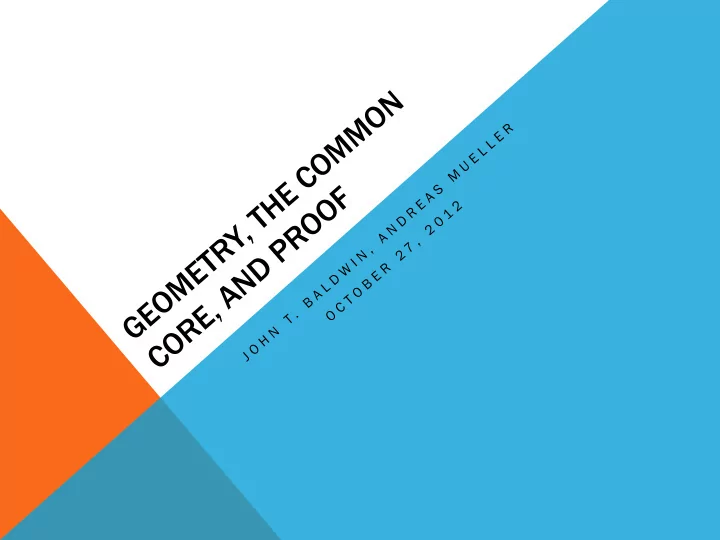

MOTIVATING PROBLEM Cut a segment into n equal parts, let’s say five: Patty paper with a segment; lined paper; four points Correspondence with last week’s construction
HOMEWORK: 1. and 2. Importance of exact language 2. Importance of exact notation 3. Intuition and exact language / definition 4. Theorems: tools of convenience (SAS) and understanding (all right angles are congruent)
RU RUST STY Y COMPAS ASS S REVISIT SITED ED Rationale le for r constr structi uction on; intro to Geogebra bra Basic tools: points, segments, rays, color, thickness, font Construction protocol
RIGID MOTION: GEOGEBRA Translations (along a vector with given direction and length) Reflections (in a line) Rotations (about a point by an angle
DEFINE USING TRANSFORMATIONS: Isosceles triangle Make an isosceles triangle in Geogebra using transformations Equilateral/equiangular triangle Make an equilateral triangle in Geogebra using transformations
THEOREM 3.22: THE BASE ANGLES OF AN ISOSCELES TRIANGLE ARE CONGRUENT. Rewrite Euclid’s proof as a two column proof Is there a simpler proof using our axioms so far?
EQUILATERAL TRIANGLES Prove that the angles are 60 degrees, i.e. 1/6 of a turn (a circle can be cut into 6 equal parts using the radius, i.e. a regular hexagon can be made from six equilateral triangles) Prove that equilateral triangles are equiangular
REFOCUS AND REPURPOSE OURSELVES ON THE MOTIVATING PROBLEM Prove with any theorems why the construction works What concepts/theorems are we using that we need to prove first? Similar triangles and ratios Parallel lines and parallelograms
PARALLEL LINE POSTULATE What is it? Existence vs. Uniqueness Euclid
PROPOSITION 16: EXTERIOR ANGLE THEOREM Understand Euclid’s proof: rewrite in modern English in paragraph form Use it to prove the Alternate Interior Angle Theorem (if alternate interior angles are congruent, then the lines are parallel)
WHY DO WE STILL NEED A PARALLEL LINE POSTULATE? Not for existence, but for uniqueness Axiom 3.31: If the lines are parallel, then alternate interior angles are equal How does that prove uniqueness? State the contrapositive of the above statement Compare it to Euclids “Parallel Line” Postulate
MAKING PARALLEL LINES • Compass and Straight Edge • Geogebra • Patty Paper • Triangle Tool
PARALLEL LINES: COMPASS AND STRAIGHT EDGE Making perpendicular lines Transversal and alternate interior angles Transversal and corresponding angles Transversal and same-side interior angles
USING GEOGEBRA Parallel line command Translation command Rotation command Reflection command
PATTY PAPER Perpendicular of a perpendicular Rotation Reflection
PARALLEL LINE TOOL Straight edge and drafting triangle Why does it work?
THE ANGLE SUM OF A TRIANGLE Prove that the angles of an equilateral/equiangular triangle are 60 degrees, i.e. 1/6 of a circle Why do we need the Parallel Line Postulate to prove it?
PARALLELOGRAMS Definition Theorems about parallelograms
PARALLELOGRAMS Definition A quadrilateral with two pairs of parallel sides is a parallelogram
PARALLELOGRAMS Theore rems ms about ut parallelogr lograms ms Which ones require the Parallel Line Postulate?
WHAT ELSE DO WE NEED? Similar Triangles • • Ratios and Rational Numbers • Multiplication and Division • Area
Recommend
More recommend